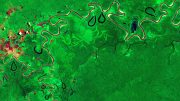
Researchers from NAU and the U.S. Forest Service have developed new NSVB models, revolutionizing forest biomass and carbon estimation in the U.S. This leads to a significant increase in predicted biomass and carbon content, influencing future forest conservation strategies and sustainable management practices.
Forests serve as crucial players in the fight against climate change due to their ability to absorb and store carbon. A recent study, with contributions from researchers at Northern Arizona University, is poised to revolutionize forest conservation strategies across the United States. This study introduces innovative and precise models designed to more accurately estimate and forecast the carbon storage capacity of forests.
The U.S. Forest Service, along with an impressive list of research partners including those at Northern Arizona University, has introduced new National Scale Volume Biomass (NSVB) models that provide a consistent and scientifically accurate method to predict tree volume, biomass (a term that describes the collective mass of the woody parts of trees) and carbon content nationwide.
Enhanced Accuracy in Biomass and Carbon Predictions
A key finding from the study is that newly developed models produce substantially higher values in biomass and carbon estimates when compared with previous models. The NSVB produces an estimated 34.71 billion tons of biomass in U.S. forests, compared with 30.28 billion tons using previous methods, indicating a potential increase of 14.6 percent in aboveground tree biomass over what was previously estimated. This enhanced precision is achieved by using newly developed species carbon fractions instead of a constant conversion factor.
“This pioneering initiative is a multi-year effort involving multiple partners who meticulously compiled records from nearly 280,000 trees,” NAU faculty and research team member Andrew Sánchez Meador said. “These models are testaments to the Forest Service’s commitment to advancing scientific knowledge and ensuring the sustainable management of our nation’s forests.”
Significant Findings for Arizona
The findings associated with Arizona are particularly noteworthy. For Arizona, the estimated merchantable wood volume is expected to increase by 1.1 percent, while the estimated aboveground biomass is expected to increase by 21.7 percent.
“A striking finding is how the new models predicted increases in the biomass in tops and limbs, which increased by 115 percent,” said School of Forestry Interim Executive Director David Auty, who also is on the team. “This increase has implications for previous carbon estimates, suggesting that the carbon storage capacity in these components of the trees has been previously underestimated.”
The NSVB models also serve as a foundation for research on carbon, old growth, and forest sustainability, and inform the implementation of strategies such as the national Wildfire Crisis Strategy. By providing a nationally consistent framework and biomass estimates for all tree components, the NSVB addresses inconsistencies in regional or state volume models.
“This groundbreaking research is an important step toward a sustainable future,” Auty said. “It underscores the Forest Service’s dedication to fostering the health, diversity, and productivity of the nation’s forests and grasslands to meet the needs of present and future generations.”
Reference: “A national-scale tree volume, biomass, and carbon modeling system for the United States” by James A. Westfall, John W. Coulston, Andrew N. Gray, John D. Shaw, Philip J. Radtke, David M. Walker, Aaron R. Weiskittel, David W. MacFarlane, David L.R. Affleck, Dehai Zhao, Hailemariam Temesgen, Krishna P. Poudel, Jereme M. Frank, Stephen P. Prisley, Yingfang Wang, Andrew J. Sánchez Meador, David Auty and Grant M. Domke, 2023.
DOI: 10.2737/WO-GTR-104
After extensive peer review, the report is now available on the Forest Service’s website, and the data is openly available at legacytreedata.org.









This story seems to come to different conclusions than the similar story from January 17th.
https://scitechdaily.com/carbon-sinks-in-crisis-climate-change-threatens-global-forest-co2-sequestration/
Would it were that researchers showed a little more humility in their claims.